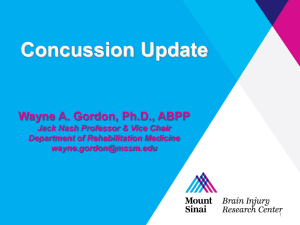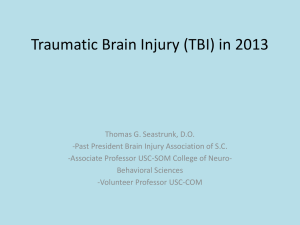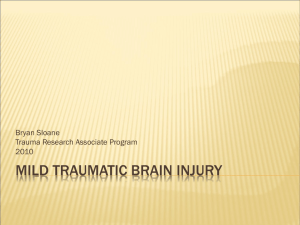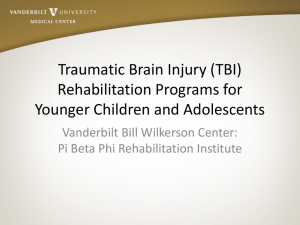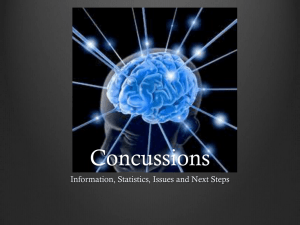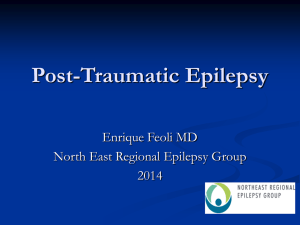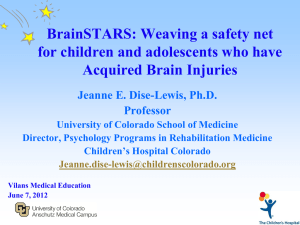Brain Injury 101: What You Need to Know
advertisement
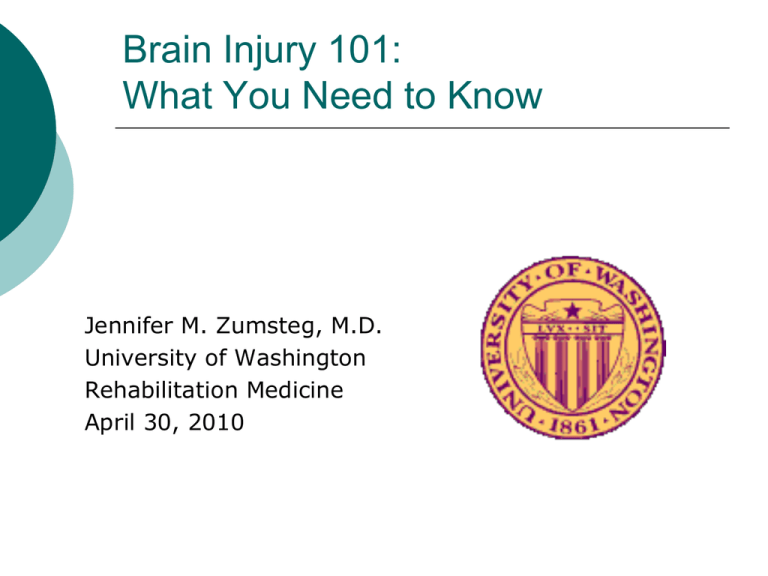
Brain Injury 101: What You Need to Know Jennifer M. Zumsteg, M.D. University of Washington Rehabilitation Medicine April 30, 2010 Thanks to Kathleen R. Bell, M.D. for slides Sign-up for slides – a copy will be emailed to you Bill Johnson, a U.S. Olympic gold medalist in downhill skiing, went into a coma and suffered brain injuries after this hard fall on March 22, 2001, in Big Mountain, Mont. “The decision-making process is not one of his strong suits now”, Kakes (friend and neighbor) said. “He just raises his voice. He’s not a swearing kind of person”, DB Johnson said. “He’ll get mad at me and I’ll stop him and say ‘Why are you mad at me?’ He’ll say, ‘I’m not mad at you.’ He doesn’t realize he’s doing it.” Gold-Medal Skier Bill Johnson Arrested UPDATED - Sunday February 13, 2005 10:39am from our sister station WJLA-TV PORTLAND, Ore. (AP) - Olympic ski champion Bill Johnson was charged with assaulting an officer and resisting arrest after punching a sheriff's deputy in the face during a traffic stop, police said. “The problem became especially apparent earlier this year when he was pulled over by police and, because of his speech, suspected of drunk driving. There was no alcohol in his system, but Johnson became so agitated that he was arrested and charged with assault. Now he doesn’t drive, relying on family and friends…” Outline of Presentation Epidemiology and prevalence of Traumatic Brain Injury (TBI) What is TBI and how does it happen? Moderate to severe TBI Mild TBI (Concussion) The results of TBI Medical Cognitive Behavioral Epidemiology of Traumatic Brain Injury 1 million people are treated and released from hospital emergency departments each year 230,000 people/year are hospitalized and survive 50,000 people die each year 5.3 million Americans are living today with a TBI-related disability Risk Factors and Causes WHO? Males, adolescents, young adults, older than 75 WHAT? Motor vehicle crashes Violence Falls Military Sports/Recreational Costs of TBI Direct annual expenditures Indirect annual costs $4.5 billion $33.3 billion Total costs $37.8 billion (in 1985 dollars) Mechanisms of Injury Primary mechanism Penetrating (high velocity, more damage, e.g., gunshot wound) Lacerating and crushing Cavitation Shock waves Skull and bullet fragments Closed/ModerateSevere High velocity translational (inferior frontal and temporal lobes) High velocity rotational (shearing at grey-white interface) Diffuse axonal injury Blunt Force skull fracture contusion at point of impact contrecoup injury (fall) Primary Space occupying lesions epidural hematomas 6% subdural hematomas 24% intracerebral hemorrhage/intraventricular hemorrhage herniation from mass effect Secondary Brain Injury altered cerebral blood flow hypotension release of neurotoxic compounds cellular inflammatory response cytokines calcium influx oxygen free radicals Blast Injury: More of the Same? Likely same types of brain injury High stress environment Associated injuries: hearing loss, limb injury PTSD/Anxiety Disorders Glasgow Coma Scale Best Eye Response. (4) Best Verbal Response. (5) No eye opening. Eye opening to pain. Eye opening to verbal command. Eyes open spontaneously. No verbal response Incomprehensible sounds. Inappropriate words. Confused Orientated Best Motor Response. (6) No motor response. Extension to pain. Flexion to pain. Withdrawal from pain. Localising pain. Obeys Commands. E + V + M = Total Severe 3-8 Moderate 9-12 Mild 13-15 Posttraumatic Amnesia length of time from the point of injury until the individual has a continuous memory for ongoing events Better predictor of functional outcome than GCS Mild Traumatic Brain Injury (Concussion) What is concussion? Mild Traumatic Brain Injury (MTBI) Defined by symptoms (1 or more) Any period of observed or self-reported Transient confusion, disorientation or impaired consciousness Dysfunction of memory around the time of the injury Loss of consciousness lasting less than 30 minutes Observed signs of neurological or neuropsychological problem Seizures right afterwards Young children – irritability, lethargy, vomiting Symptoms like headache, dizziness, irritability, fatigue or poor concentration soon after injury What Happens in the Brain? Decreased blood flow May not see it for 2-3 days afterwards and can last for a week Hyperglyocolysis (high metabolism) Excitotoxicity (glutamate) Abnormal ion flows from cells How often does it happen? Centers for Disease Control estimates: 1.5 million people a year have a TBI About 75% of these are mild (like concussions) Don’t really know how many because: No one keeps track outside of hospitals Lots of concussions aren’t reported to anyone How do people get concussions? YOU DON’T HAVE TO BE KNOCKED OUT TO HAVE A CONCUSSION!! Features of concussion Vacant stare (befuddled expression) Delayed verbal and motor responses Confusion and inability to focus attention Disorientation Slurred or incoherent speech Gross observable incoordination Features of concussion Emotions out of proportion to circumstances Memory deficits Any period of loss of consciousness Symptoms of concussion Early symptoms Headache Dizziness or vertigo Lack of awareness of surroundings Nausea or vomiting Late symptoms of concussion Persistent low grade headache Light-headedness Poor attention and concentration Memory dysfunction Easy fatiguability Irritability and low frustration tolerance Intolerance of bright lights or diffulty focusing vision Intolerance of loud noises, ringing in the ears Anxiety and/or depressed mood Sleep disturbance The Results of TBI Dysautonomia hypertension (HTN), fever, tachycardia, tachypnea, pupillary dilation, and extensor posturing Elevated catecholamine levels in proportion to the severity of injury, diffuse axonal injury, and brainstem injury Treatment for posturing Range of motion Splinting or casting Botulinum toxin or phenol injections Dantrolene Control of dysautonomic episodes Metabolic/Electrolyte Disturbances Disorders of Sodium: Syndrome of Inappropriate Antidiuretic Hormone (SIADH) hyponatremia, lethargy, nausea, seizures exclude adrenal insufficiency, drug causes (carbamazepine) water restriction, free sodium use, NSS Metabolic/Electrolyte Disorders Disorders of sodium: Diabetes insipidus polydipsia, polyuria, hypernatremia, fatigue, altered mental status treatment: 1-d-amino-8-D-argininevasopressin (DDAVP) nasal spray, carbamazepine Neurological Complications Nervous System - Late Intracranial Mass Lesions Subdural Hematoma Acute immediate Subacute days Chronic weeks 3-20 >3 Hydrocephalus Clinical presentation: classic - dementia, ataxia, urinary incontinence TBI - loss of upgaze, akinetic mutism Headache, nausea, vomiting and lethargy or decreasing mental status Hypertension Usually within 30 days but can be further delayed Risk Factors for Hydrocephalus Subarachnoid hemorrhage More severe injuries Skull fractures (depressed) Infectious processes Hydrocephalus CNS Infection Risk factors: depressed skull fractures basilar skull fractures and fistulas CSF leaks (otorrhea, rhinorrhea) pneumocephalus penetrating injuries cranioplasty Types of Infections Meningitis Brain Abscess Subdural Empyema Skull Osteomyelitis Seizures Incidence: 2-2.4% entire population with TBI Mild 1.5, Moderate 2.9, Severe 17.0 Early – week one Late – after one week Most initial seizures (80%) will occur in the first 2 years Risk Factors for Seizures Severity of trauma Penetrating head injuries Intracranial hematoma Depressed skull fracture Hemorrhagic contusion Coma lasting more than 24 hours Early PTS Types of Seizures Generalized tonic-clonic Partial or focal simple - consciousness maintained complex - consciousness impaired Pseudoseizures (psychogenic) Temporal lobe (psychic, sensory, behavior) Orbitofrontal (automatisms, behavior) Seizure management Important to prevent further brain injury For moderate to severe TBI, standard of care is to treat with antiepileptic drugs (usually Dilantin) for one week Afterwards, treat only if seizure recurs Problems with AEDs: sedation, slowed learning, ataxia Seizure management Driving – Washington State requires 6 months seizure-free before resuming driving Duration of Treatment? Endocrine Disorders Approximately 20% of persons with moderate to severe injuries Hypothalamic-pituitary-adrenal axis regulation Hypothalamus CRH TRH GHRH GRH PRH/PIH CRH Anterior Pituitary GH TSH FSH LH ACTH ACTH Adrenal Glands Cortisol Types of Disorders Hypothyroidism Growth Hormone deficiency Hypogonadism Motor Disorders Spastic hypertonia Contractures Ataxia Tremor Dystonia Parkinsonism Tics Musculoskeletal Involvement after TBI Limb Fractures 62% have associated fractures ~10% undiagnosed at time of rehab admission 5% cervical spine Open reduction and fixation Frequently missed - distal radius Peripheral nerve injuries Also about 10% undiagnosed initially Heterotopic Ossification Occurrence: 11-35% of patients Risk factors: prolonged coma, spasticity, pressure ulcers, edema, skeletal trauma, increased severity of brain injury Large joints (hip, shoulder, elbow) Visual Disorders Visual deficits Affects vision, balance, cognition Cranial nerve injuries Occipital cortex injury Visual field loss, cortical blindness Optic tract injury 3, 4, 6th nerve resulting in decreased eye movements and diplopia Variety of visual field loss patterns Visuoperceptual or visuospatial deficits Post-trauma vision syndrome Can occur even after mild TBI Problem in near focusing and movements involving eye-teaming Saccades (overshooting) Pursuit (blurring) Treatments: Time, visual occlusion, prism lenses, eye exercises, surgery Dizziness and Balance Impairment Central vertigo Benign paroxysmal positional vertigo Epson maneuver Vision Motor impairment Special Senses Anosmia – loss of smell Up to 50% of persons with moderate to severe TBI Parosmia – altered smell Posttraumatic Headache Most common symptom following mild or minor injury (30-50%) Somewhat less common with increasing severity of brain injury Possibly anatomic reasons that more women complain of PTHA than men Posttraumatic Headache Tension-type PTHA - dull, aching, varying intensity, chronic or episodic PT migraine headache Mixed posttraumatic headache Cluster-like headache - unusual Temporomandibular joint syndrome (dental pain) Posttraumatic Headache Contributing factors: psychosocial stress, anxiety, depression, sleep disorder Natural history: improvement Treatment: directed at suspected type and contributing factors Behavioral and Affective Disorders Acute in hospital: Agitation Rule out delirium Sepsis Medications Electrolyte Imbalance Late neurological complications Detox Inversely related to level of attention Post Acute Behavioral Syndromes Episodic Dyscontrol Impulsivity Possible temporal or frontal lobe seizure Agitated Depression Depression Anxiety Disorder Psychotic Disorders Substance Abuse Disorders Cognitive Deficits Emergence of Deficits For milder injuries, as function improves, deficits may become more apparent and disturbing formal testing vs “everyday life” For mild injuries, residual problems may become evident on return to work Cognitive Deficits Intellectual deficits Memory and Learning deficits among the most common effects (major reason for failure to RTW) learning, retention, and retrieval of new information Attentional Deficits usually quite modest after recovery reduced capacity to sustain and to divide attention Slowed processing time Cognitive Deficits Executive function lack of flexibility, impersistence, perseveration, planning, lack of initiation, foresight, problem-solving, quality control subtle and pervasive Insight and denial anosognosia - unawareness of deficit parallel process in family members Language and Communication significant dysphasia uncommon problems with conversational fluency and naming common pragmatics: clarity of expression, style, appropriateness of subject, body language Emotional and Behavioral Changes Personality change Lack of Insight Undercontrol (lability) Apathy and tiredness Depressed and anxious mood self-report 20%, relatives report 60% 1/5 contemplate suicide during 1st five years obsessional or phobic behavior Stress disorders Emotional and Behavioral Changes Social behavior loss of social skills (talk excessively, socially embarrassing style, intrusive or prying, withdrawing) loss of ability to “read” social behavior Psychiatric diagnoses often do not quite meet DSM-IV criteria

